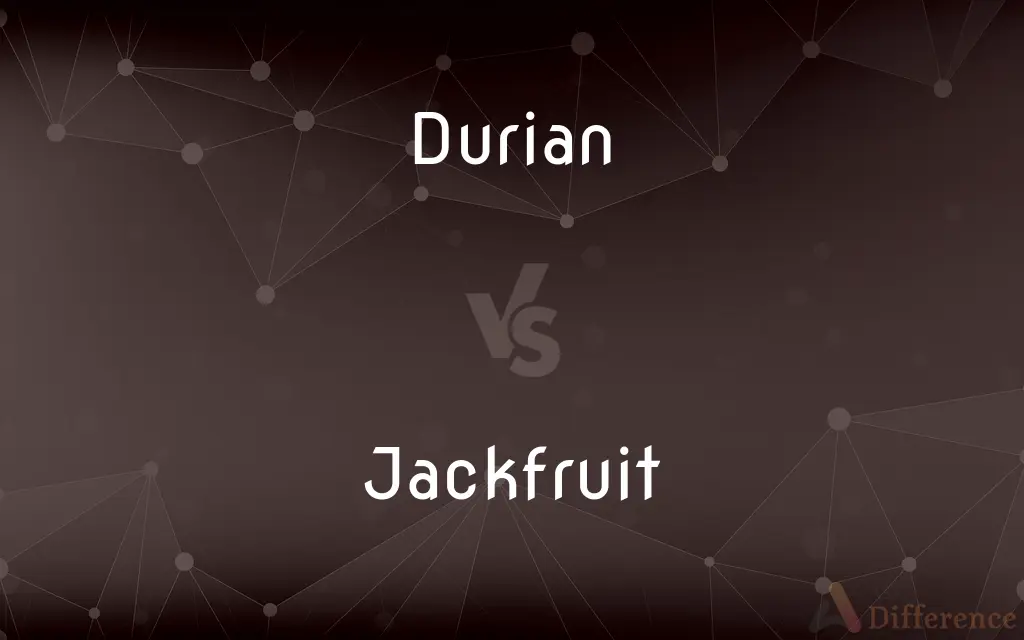Durian vs. Jackfruit — What's the Difference?
By Tayyaba Rehman & Fiza Rafique — Updated on March 21, 2024
Durian is known for its strong odor and creamy taste, while jackfruit is appreciated for its sweet, fruity flavor and fibrous texture.

Difference Between Durian and Jackfruit
Table of Contents
ADVERTISEMENT
Key Differences
Durian and jackfruit are two exotic fruits that often get confused due to their large size and spiky exterior, but they have distinctive characteristics and flavors. Durian, often called the "king of fruits," is notorious for its strong, pungent smell which can be off-putting to some, while its flesh is creamy, rich, and has a unique taste that is loved by many. Jackfruit, on the other hand, is the largest tree fruit and has a sweet, subtle flavor and a meaty, fibrous texture that makes it a popular meat substitute in vegetarian and vegan recipes.
The texture of durian and jackfruit flesh differs significantly. Durian has a creamy, custard-like texture that melts in your mouth, which contrasts sharply with jackfruit’s firmer, chewier texture that is similar to that of pulled pork when cooked. This textural difference is a key factor in their culinary uses; durian is often eaten fresh or used in sweet dishes like cakes and candies, whereas jackfruit is versatile, used both in sweet desserts and savory dishes.
In terms of aroma, durian is infamous for its strong odor, which has been described variously as resembling rotten onions, turpentine, and raw sewage. This smell is so potent that durian is banned from many hotels and public transportation systems in Southeast Asia. Jackfruit, however, has a more pleasing fruity scent, reminiscent of a combination of apple, banana, mango, and pineapple, making it more universally acceptable in terms of smell.
Both fruits offer health benefits but differ in their nutritional profiles. Durian is high in calories and fat, making it quite rich, with a significant amount of vitamins C and B, as well as potassium and dietary fiber. Jackfruit is lower in calories but rich in vitamin C, dietary fiber, and also provides a good amount of protein compared to other fruits, making it a nutritious addition to the diet.
Despite their differences, durian and jackfruit share some commonalities. Both are native to Southeast Asia and have a hard, spiky exterior that requires careful handling. They also play significant cultural roles in their native regions and are becoming increasingly popular worldwide as global cuisine becomes more accessible.
ADVERTISEMENT
Comparison Chart
Flavor
Creamy, rich, unique taste
Sweet, subtle, fruity flavor
Texture
Custard-like, creamy
Meaty, fibrous
Aroma
Strong, pungent (often compared to rotten onions)
Pleasant, fruity (resembles apple, banana)
Culinary Uses
Eaten fresh, sweet dishes
Versatile: sweet and savory dishes
Nutritional Content
High in calories, vitamins C and B, potassium
Lower in calories, high in vitamin C, dietary fiber, and protein
Exterior
Hard, spiky
Hard, spiky, larger than durian
Cultural Significance
Known as the "king of fruits" in Southeast Asia
Largest tree fruit, used as meat substitute
Compare with Definitions
Durian
Rich in calories and fat.
Durian is often referred to as a natural cheese cake due to its creamy texture.
Jackfruit
Known for its sweet, fruity flavor.
Jackfruit is commonly used in smoothies and desserts.
Durian
A tropical fruit known for its strong odor.
Despite its smell, durian is considered a delicacy.
Jackfruit
High in vitamin C and dietary fiber.
Jackfruit is nutritious, making it a great addition to the diet.
Durian
Native to Southeast Asia.
Durian is widely celebrated and consumed in countries like Thailand and Malaysia.
Jackfruit
Acts as a meat substitute.
Young jackfruit is used in vegan recipes due to its texture.
Durian
Consumed fresh or in desserts.
Durian cake is a popular dessert in Southeast Asia.
Jackfruit
Versatile in culinary uses.
Jackfruit can be used in both sweet and savory dishes.
Durian
Its smell can be controversial.
The pungent smell of durian leads to its ban in many public places.
Jackfruit
Native to Southeast Asia but popular worldwide.
The popularity of jackfruit is growing in western countries.
Durian
The durian () is the edible fruit of several tree species belonging to the genus Durio. There are 30 recognised Durio species, at least nine of which produce edible fruit, with over 300 named varieties in Thailand and 100 in Malaysia, as of 1987.
Jackfruit
The jackfruit (Artocarpus heterophyllus), also known as jack tree, is a species of tree in the fig, mulberry, and breadfruit family (Moraceae). Its origin is in the region between the Western Ghats of southern India, all of Sri Lanka and the rainforests of Malaysia.The jack tree is well-suited to tropical lowlands, and is widely cultivated throughout tropical regions of the world.
Durian
A spiny oval tropical fruit containing a creamy pulp. Despite its fetid smell it is highly valued for its flavour.
Jackfruit
A tropical evergreen tree (Artocarpus heterophyllus) of South and Southeast Asia, widely cultivated for its very large edible fruits, having pulpy yellow flesh.
Durian
The large tree that bears the durian, native to Malaysia.
Jackfruit
The fruit of this tree.
Durian
A tree (Durio zibethinus) of Southeast Asia, bearing edible fruit.
Jackfruit
A tree, Artocarpus heterophyllus, of the Moraceae family, which produces edible fruit.
Durian
The fruit of this plant, having a hard prickly rind and soft pulp with a strong odor.
Jackfruit
The large fruit from this tree.
Durian
Any of several trees, genus Durio, of Southeast Asia.
Jackfruit
East Indian tree cultivated for its immense edible fruit and seeds
Durian
The spiky edible fruit of this tree, known for its strong taste and very strong, unpleasant odor.
Jackfruit
Immense East Indian fruit resembling breadfruit of; its seeds are commonly roasted
Durian
(uncountable) A deep, rich yellow colour, like that of durian flesh (also called durian yellow).
Durian
The fruit of the durio. It is oval or globular, and eight or ten inches long. It has a hard prickly rind, containing a soft, cream-colored pulp, of a most delicious flavor and a very offensive odor. The seeds are roasted and eaten like chestnuts.
Durian
Tree of southeastern Asia having edible oval fruit with a hard spiny rind
Durian
Huge fruit native to southeastern Asia `smelling like Hell and tasting like Heaven'; seeds are roasted and eaten like nuts
Common Curiosities
Can durian and jackfruit be used interchangeably in recipes?
Due to their distinct flavors and textures, durian and jackfruit are not typically interchangeable in recipes.
What are the culinary uses of durian?
Durian is primarily used in sweet dishes like cakes, ice cream, and candies, and is also enjoyed fresh.
What is the main difference between durian and jackfruit?
The main difference lies in their smell and taste: durian has a strong, pungent odor and a creamy taste, while jackfruit is sweet and fruity with a fibrous texture.
How do you eat jackfruit?
Jackfruit can be eaten fresh or cooked, used in both sweet desserts and savory dishes, such as curries and as a meat substitute in vegan recipes.
Which fruit is bigger, durian or jackfruit?
Jackfruit is typically larger than durian and is considered the largest tree fruit.
Is jackfruit good for health?
Yes, jackfruit is nutritious, offering high amounts of vitamin C, dietary fiber, and protein, making it a healthy addition to the diet.
Why is jackfruit used as a meat substitute?
Jackfruit's meaty, fibrous texture makes it an ideal meat substitute in vegetarian and vegan recipes, especially when young and unripe.
Why is durian banned in some places?
Durian is banned in some public places due to its strong, sometimes unpleasant smell that many find offensive.
Can you eat durian raw?
Yes, durian is commonly eaten raw, and enjoying its fresh, creamy pulp is a popular way to consume it.
Is durian high in calories?
Yes, durian is relatively high in calories and fat compared to many other fruits, contributing to its rich texture and flavor.
Share Your Discovery

Previous Comparison
Enthalpy vs. Entropy
Next Comparison
Melon vs. PumpkinAuthor Spotlight
Written by
Tayyaba RehmanTayyaba Rehman is a distinguished writer, currently serving as a primary contributor to askdifference.com. As a researcher in semantics and etymology, Tayyaba's passion for the complexity of languages and their distinctions has found a perfect home on the platform. Tayyaba delves into the intricacies of language, distinguishing between commonly confused words and phrases, thereby providing clarity for readers worldwide.
Co-written by
Fiza RafiqueFiza Rafique is a skilled content writer at AskDifference.com, where she meticulously refines and enhances written pieces. Drawing from her vast editorial expertise, Fiza ensures clarity, accuracy, and precision in every article. Passionate about language, she continually seeks to elevate the quality of content for readers worldwide.














































